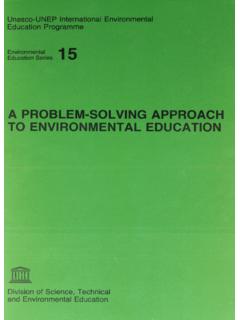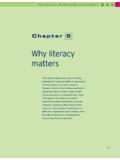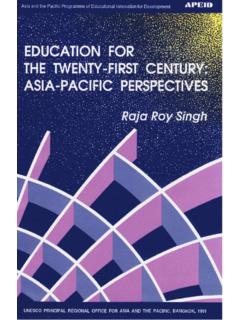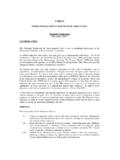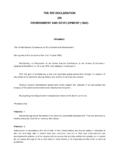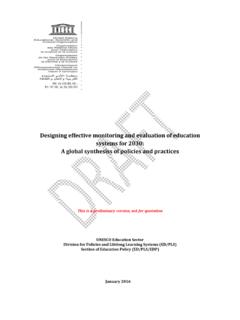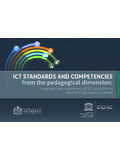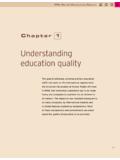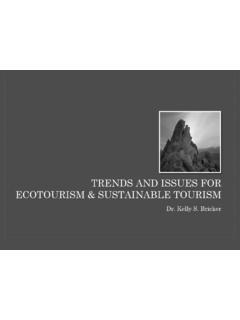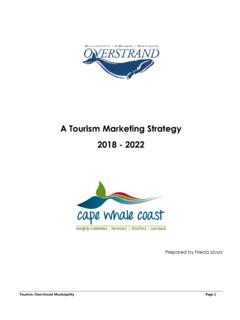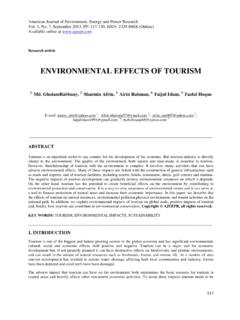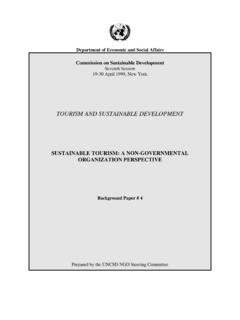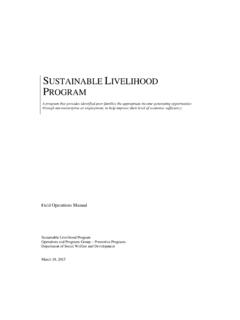Transcription of Culture and development - UNESCO
1 Culture : a driver and an enabler of sustainable development Thematic Think Piece UNESCO . The views expressed in this paper are those of the signing agencies and do not necessarily reflect the views of the United Nations. May 2012. Following on the outcome of the 2010 High-level Plenary Meeting of the General Assembly on the Millennium development Goals, the United Nations Secretary-General established the UN System Task Team in September 2011 to support UN system-wide preparations for the post-2015 UN development agenda, in consultation with all stakeholders.
2 The Task Team is led by the Department of Economic and Social Affairs and the United Nations development Programme and brings together senior experts from over 50 UN entities and international organizations to provide system-wide support to the post-2015 consultation process, including analytical input, expertise and outreach. 2. Culture : a driver and an enabler for sustainable development 1. Introduction The Outcome Document of the 2010 MDG Summit, 1 published ten years after the Millennium Declaration, emphasized the importance of Culture for development and its contribution to the achievement of the Millennium development Goals.
3 These crucial messages were reiterated in two consecutive Culture and development UNGA Resolutions in 2010 and 2011, which called for the mainstreaming of Culture into development policies and strategies, and underscored Culture 's intrinsic contribution to sustainable development . The forthcoming ECOSOC Annual Ministerial Review on Science, technology and innovation, and the potential of Culture , for promoting sustainable development and achieving the Millennium development Goals will be an opportunity to address the direct nexus between Culture and the achievement of the MDGs.
4 The post-2015 agenda should take into account the critical lessons learned on the two ways in which Culture fosters sustainable development : as a driver and as an enabler. 2. Culture drives sustainable development Throughout the past decade, statistics, indicators and data on the cultural sector, as well as operational activities have underscored that Culture can be a powerful driver for development , with community-wide social, economic and environmental Of particular relevance is the cultural sector's contribution to the economy and poverty alleviation.
5 Cultural heritage, cultural and creative industries, sustainable cultural tourism , and cultural infrastructure can serve as strategic tools for revenue generation, particularly in developing countries given their often-rich cultural heritage and substantial labour force. 1 United Nations General Assembly, Outcome Document of the 2010 Millennium Summit, Keeping the promise: united to achieve the Millennium development Goals, A/65 (New York, 2010). 2 By January 2012, Culture was included in 70% of the United Nations development Assistance Frameworks. 3.
6 Cultural and creative industries represent one of the most rapidly expanding sectors in the global economy with a growth rate of % in the Middle East, % in Africa, % in South America, % in Asia, % in Oceania, and % in North and Central Promoting this sector requires limited capital investment, involves low entry barriers and can have a direct impact on vulnerable populations, including women. In Ecuador, recent studies show that the formal and private cultural activities contributed to the 2010. GDP and in the same year, of the total employed population worked in cultural occupations.
7 Almost 60% of the latter were Furthermore, the tourism sector has become one of the world's fastest growing economic sectors. Gross worldwide tourism receipts grew at an average rate of 7 % from 1998 to 2008, with 12 % for the Least Developed Countries for the same Cultural tourism - that relies on tangible and intangible cultural assets - accounts for 40 % of world tourism revenues. Investment in Culture and creativity has proven an excellent means for revitalize the economy of cities. Today, many cities use cultural heritage and cultural events and institutions to improve their image, stimulate urban development , and attract visitors as well as investments.
8 Most Middle-Income Countries are developing vibrant Culture sectors and initiatives and request assistance in this area. Culture -led development also includes a range of non-monetized benefits, such as greater social inclusiveness and rootedness, resilience, innovation, creativity and entrepreneurship for individuals and communities, and the use of local resources, skills, and knowledge. Respecting and supporting cultural expressions contribute to strengthening the social capital of a community and fosters trust in public institutions. Cultural factors also influence lifestyles, individual behaviour, consumption patterns, values related to environmental stewardship, and our interaction with the natural environment.
9 Local and indigenous knowledge systems and environmental management practices provide valuable insight and tools for tackling ecological challenges, preventing biodiversity loss, reducing land degradation, and mitigating the effects of climate change. 3 PricewaterhouseCoopers (PwC), 2008. 4 Recent UNESCO Statistics (March 2012) obtained through the Culture for development Indicators Suite (CDIS). funded by Spain, Figures are preliminary. Based on the UNESCO Framework for Cultural Statistics, the methodology of the CIDS economic indicator on GDP distinguishes between central cultural activities which represented , and equipment and support cultural activities which reached 2,02% in Ecuador for 2010.
10 5 World tourism Organization, UNWTO tourism Highlights, 2011 Edition (Madrid, 2011). 4. The UN Inter-agency projects, implemented under the MDG-F Achievement Fund6 carried out in recent years, have demonstrated concretely the power of Culture to respond to gender issues, to health and environment concerns, to challenges in the areas of education and livelihoods let alone the fact that these projects have generated new jobs, new market opportunities, and greater income levels, that they have improved living conditions and fostered community-based economic growth, and contributed to empowering individuals.

